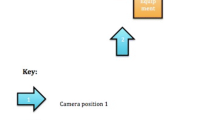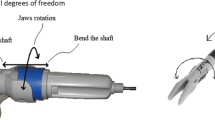Abstract
Background
One of the key problems in laparoscopy is the ergonomic positioning of the monitor. In this study we tested task performance and muscle strain of subjects in relation to monitor position during laparoscopic surgery.
Methods
Eighteen subjects simulated laparoscopic suturing by threading tiny pearls with a curved needle. This was repeated in three monitor positions (15 min each): frontal at eye level (A), frontal in height of the operating field (B), and 45° to the right side at eye level (C). Subjects were not allowed to turn their heads during these sessions. After the test they were asked for their preferred monitor position. During all tests the electromyographic (EMG) activity of the main neck muscles was recorded and the number of pearls was counted.
Results
The EMG activity was significantly lower for position A compared to positions C and B (p < 0.05). No significant difference was found between positions B and C. The number of threaded pearls as an indicator for task performance was highest for position B. The difference was statistically significant compared to position C (p = 0.0008) but not between positions A and C (p = 0.0508) or A and B (p = 0.0575). When asked for the preferred monitor position, nine subjects chose two monitors in the frontal positions A and B. No subject preferred the monitor at the side position (C).
Conclusion
Regarding EMG data, the monitor positioned frontal at eye level is preferable. Reflecting personal preferences of subjects and task performance, it should be of advantage to place two monitors in front of the surgeon: one in position A for lowest neck strain and the other in position B for difficult tasks with optimal task performance. The monitor position at the side is not advisable.






Similar content being viewed by others
References
A Aaras KI Fostervold O Ro M Thoresen S Larsen (1997) ArticleTitlePostural load during VDU work: a comparison between various postures Ergonomics 40 1255–1268 Occurrence Handle10.1080/001401397187496 Occurrence Handle1:STN:280:DyaK1c%2FktlWltQ%3D%3D Occurrence Handle9375538
DH Birkett (1995) ArticleTitleThree-dimensional laparoscopy J Laparoendosc Surg 5 327–331 Occurrence Handle1:STN:280:BymC3MnhvFQ%3D Occurrence Handle8845507
EN Corlett (1995) The evaluation of posture and its effects JR Wilson EN Corlett (Eds) Evaluation of human work. A practical ergonomics methodology Taylor & Francis London 689–692
P Faul (1993) ArticleTitleVideo TUR: raising the gold standard-new aspects, techniques and tendencies to minimize invasiveness Eur Urol 24 256–261 Occurrence Handle1:STN:280:ByyA1cjjsl0%3D Occurrence Handle8375449
E Grandjean (1991) Physiologische Arbeitsplatzgestaltung Ecomed Landsberg, ISBN 3-609–644605
R Griesel (1995) Apparative Ausrustung und Instrumente in der minimal invasiven Chirurgie A Pier E Schippers (Eds) Minimal invasive chirurgie: grundlagen, techniken, ergebnisse, trends Thieme Stuttgart 72–75
GB Hanna S Shimi A Cuschieri (1997) ArticleTitleInfluence of direction of view, target-to-endoscope distance and manipulating angle on endoscopic knot tying Br J Surg 84 1460–1464 Occurrence Handle10.1111/j.1365-2168.1997.02835.x Occurrence Handle1:STN:280:DyaK1c%2FislKrtw%3D%3D Occurrence Handle9361614
GB Hanna S Shimi A Cuschieri (1997) ArticleTitleOptimal port locations for endoscopic intracorporal knotting Surg Endos 11 397–401 Occurrence Handle10.1007/s004649900374 Occurrence Handle1:STN:280:ByiB2M%2Fnt1Q%3D
GB Hanna S Shimi A Cuschieri (1998) ArticleTitleTask performance in endoscopic surgery is influenced by location of the image display Ann Surg 227 481–484 Occurrence Handle10.1097/00000658-199804000-00005 Occurrence Handle1:STN:280:DyaK1c3it12qtQ%3D%3D Occurrence Handle9563533
T Hettinger (1970) Angewandte Ergonomie. Arbeitsphysiologische und arbeitsmedizinische Probleme in der Betriebspraxis Bartmann Verlag Frenchen
L Lannersten K Harms-Ringdahl (1990) ArticleTitleNeck and shoulder muscle activity during work with different cash register systems Ergonomics 33 49–65 Occurrence Handle1:STN:280:By%2BB2c3otlI%3D Occurrence Handle2335166
A Luttmann J Sokeland W Laurig (1998) ArticleTitleMuscular strain and fatigue among urologists during transurethral resections using direct and monitor endoscopy Eur Urol 34 6–14 Occurrence Handle10.1159/000019670 Occurrence Handle1:STN:280:DyaK1czktFSqtA%3D%3D
EA Mueller (1935) Die Erholung nach statischer Haltearbeit E Atzler (Eds) Arbeitsphysiologie, Zeitschrift fur die Physiologie des Menschen bei Arbeit und Sport Springer-Verlag Berlin 72–79
InstitutionalAuthorNameRoyal College of Obstetricians and Gynaecologists (RCOG) (1994) Report of the RCOG working party on training in gynaecological endoscopic surgery RCOG London 8–12
F Tendick RW Jennings G Tharp L Stark (1993) ArticleTitleSensing and manipulation problems in endoscopic surgery: experiment, analysis, and observation Presence 2 66–81
MA Veelen Particlevan JJ Jakimowicz RHM Goossens DW Meijer JBJ Bussmann (2002) ArticleTitleEvaluation of the usability of two types of image display systems during laparoscopy Surg Endosc 16 674–678 Occurrence Handle10.1007/s00464-001-9116-4 Occurrence Handle1:STN:280:DC%2BD383jsVequg%3D%3D Occurrence Handle11972213
Acknowledgments
The surgical instruments were generously provided by their manufacturers. The study was supported by a grant from Karl Storz (Tuttlingen, Germany). We thank Prof. Schulte-Monting for statistical analysis (Institute for Medical Biometry and Statistics, University of Freiburg).
Author information
Authors and Affiliations
Corresponding author
Rights and permissions
About this article
Cite this article
Matern, U., Faist, M., Kehl, K. et al. Monitor position in laparoscopic surgery. Surg Endosc 19, 436–440 (2005). https://doi.org/10.1007/s00464-004-9030-7
Received:
Accepted:
Published:
Issue Date:
DOI: https://doi.org/10.1007/s00464-004-9030-7




